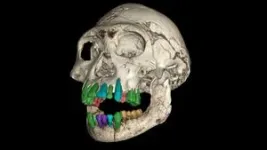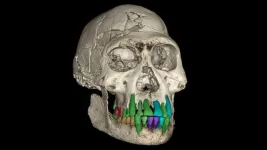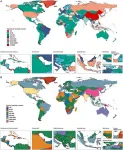(Press-News.org) In sickness or in health, the billions of microorganisms that inhabit our guts are our constant companions throughout life. In the past few decades, scientists have shown how the nature of this ‘microbiome’ can provide valuable clues to human diseases and their treatment.
A new study from the Bork group at EMBL Heidelberg, recently published in the journal Cell, reports that a number of conditions, such as lifestyle and disease, affect the total number of microbes in the gut, making this often neglected metric one that bears further evaluation in gut microbiome research.
From composition to loads
When studying microbiomes, researchers tend to focus more strongly on microbial composition – the relative proportion of different species of microbes (usually bacteria and archaea, but also protists, viruses, and other microorganisms). This tells us, for example, whether the level of one species of bacteria goes up or down compared to other species in the guts of certain disease patients.
To illustrate this, imagine that only 1,000 bacteria live in your gut. In healthy individuals, this might include 10 bacteria of species ‘red’, and 20 bacteria of species ‘blue’, so we could say red bacteria make up 2% of the microbiome while blue bacteria make up 5%. However, in individuals who have a particular disease, we might notice red bacteria make up 4% of the microbiome – a relative increase, while blue bacteria remain at 5%. We could then hypothesise that the red bacteria are associated with this disease.
On the other hand, the microbial load refers to the density of microbes inside our guts. Experimentally, it is determined as the number of microbial cells per gram of faeces. Unlike microbial composition, it is an absolute quantity. In the example above, imagine the total number of bacteria dropping to 500 as a result of disease. Looking at the absolute numbers, it’s possible that the number of red bacteria actually stayed the same while the number of blue bacteria decreased.
Scientists usually only consider microbial composition when carrying out microbiome studies because current experimental methods for measuring microbial loads are both time- and cost-intensive.
Using machine learning to make microbiome studies more robust
“We wanted to develop a new method that required no additional experimental methods to quantify microbial load,” said Suguru Nishijima, the study’s first author and a postdoc in the Bork Group. “We had access to large datasets with both microbial composition and experimentally measured microbial load data. We wanted to see if we could use these to train a machine learning model to estimate microbial load given microbial composition alone.”
The datasets used for this exercise came from GALAXY/MicrobLiver and the Metacardis consortia – large-scale EU-funded projects the Bork Group has previously contributed to. Drawn from over 3,700 individuals, these data provided an ideal way to test whether a machine-learning model could be trained to estimate the total number of microbes in a sample.
And indeed, the model created by Nishijima and his colleagues could robustly predict microbial loads, which they validated using a new dataset that the model hadn’t encountered before. Knowing that the model worked, the researchers then applied it to a huge sample of over 27,000 individuals – gathered from 159 previous studies conducted across 45 countries.
They found that many factors can influence microbial load. For example, diarrhoea can reduce the number of microbes in the gut, while constipation can increase them. Women have, on average, a higher microbial load than men (perhaps linked to the observation that women often experience constipation more frequently than men), while young people have a smaller average microbial load than elderly people. Many diseases, as well as the drugs used to treat them, significantly alter microbial load.
“Importantly, many microbial species previously thought to be associated with disease were more strongly explained by variations in microbial load. These findings suggest that changes in microbial load, rather than the disease itself, may be the driver of shifts in the microbiome in patients” said Nishijima. “However, certain disease-microbe associations remained, and this shows that these are truly robust. This further confirms the importance of including microbial load in microbiome association studies to avoid false positives or false negatives.”
Thanks to the new machine learning model these scientists developed – the first to predict microbial loads from composition data – scientists can now include this important factor in future gut microbiome studies. The model is freely and openly available to researchers worldwide to test and reuse.
This may also have implications far beyond the gut microbiome.
“Our oceans, soils, rivers – are all teeming with microbes, and understanding these microbiomes could yield valuable insights to help preserve our planetary health,” said Peer Bork, Group Leader and Director at EMBL Heidelberg and the study’s senior author. “This study shows us that microbial load is an important measure that must be taken into account in such studies. Thus, we will work towards translating the knowledge on the gut microbiome to other habitats.”
END
Microbial load can influence disease associations
Scientists have developed a new machine-learning model to predict microbial load — the density of microbes in our guts — and used it to demonstrate how microbial load plays an important role in disease-microbiome associations
2024-11-13
ELSE PRESS RELEASES FROM THIS DATE:
Three galactic “red monsters” in the early Universe
2024-11-13
An international team led by the University of Geneva (UNIGE) has identified three ultra-massive galaxies – nearly as massive as the Milky Way – already in place within the first billion years after the Big Bang. This surprising discovery was made possible by the James Webb Space Telescope's FRESCO program, which uses the NIRCam/grism spectrograph to measure accurate distances and stellar masses of galaxies. The results indicate that the formation of stars in the early Universe was far more efficient than previously thought, challenging existing galaxy formation models. The study is published in Nature.
In the theoretical model favored by scientists, galaxies form ...
First ever study finds sexual and gender minority physicians and residents have higher levels of burnout, lower professional fulfillment
2024-11-13
EMBARGOED by JAMA Network Open until 11 a.m., ET until Nov. 13, 2024
Contact: Gina DiGravio, 617-358-7838, ginad@bu.edu
(Boston)—Burnout is a public health crisis that affects the well-being of physicians and other healthcare workers, and the populations they serve. Burnout is characterized by emotional exhaustion, cynicism, lack of motivation, and feelings of ineffectiveness and inadequate achievement at work. Past studies have shown that compared to the general working U.S. population, physicians ...
Astronomers discover mysterious ‘Red Monster’ galaxies in the early Universe
2024-11-13
An international team that was led by the University of Geneva (UNIGE) and includes Professor Stijn Wuyts from the University of Bath in the UK has identified three ultra-massive galaxies – each nearly as massive as the Milky Way – that had already assembled within the first billion years after the Big Bang.
The researchers’ results indicate that the formation of stars in the early Universe was far more efficient than previously thought, challenging existing galaxy formation models.
The surprising discovery – described today in the journal Nature – was made by the James Webb Space Telescope (JWST) ...
The secrets of fossil teeth revealed by the synchrotron: a long childhood is the prelude to the evolution of a large brain
2024-11-13
The secrets of fossil teeth revealed by the synchrotron: a long childhood is the prelude to the evolution of a large brain
Could social bonds be the key to human big brains? A study of the fossil teeth of early Homo from Georgia dating back 1.77 million years reveals, thanks to the European Synchrotron (ESRF) in Grenoble, a prolonged childhood despite a small brain and an adulthood comparable to that of the great apes. This discovery suggests that an extended childhood, combined with cultural transmission ...
Obesity-fighting drugs may reduce alcohol consumption in individuals with alcohol use disorder
2024-11-13
A new joint study by the University of Eastern Finland and Karolinska Institutet in Sweden found that the GLP-1 agonists semaglutide and liraglutide, which are used for treating diabetes and obesity, were associated with fewer hospitalisations among individuals with alcohol use disorder, AUD. Fewer hospitalisations were observed for alcohol related causes, substance use related causes, and for physical illnesses. However, no association was observed for hospitalisations due to attempted suicide.
Effective treatments for alcohol dependence exist; however, they remain underused and are not effective, or suitable, for all patients with alcohol or substance use disorder. Previous ...
Does AI improve doctors’ diagnoses? Study puts it to the test
2024-11-13
With hospitals already deploying artificial intelligence to improve patient care, a new study has found that using Chat GPT Plus does not significantly improve the accuracy of doctors’ diagnoses when compared with the use of usual resources.
The study, from UVA Health’s Andrew S. Parsons, MD, MPH and colleagues, enlisted 50 physicians in family medicine, internal medicine and emergency medicine to put Chat GPT Plus to the test. Half were randomly assigned to use Chat GPT Plus to diagnose complex cases, while the other half relied on conventional methods such as medical reference sites (for example, UpToDate©) and Google. The researchers then compared the resulting ...
Extreme weather accelerates nitrate pollution in groundwater
2024-11-13
Extreme weather spurred by climate change, including droughts and heavy rains, may increase the risk of nitrates from fertilizers ending up in groundwater, according to a recent study from researchers at the University of California, Davis. The study found heavy rains after a drought caused nitrates to seep 33 feet under farm fields in as little as 10 days. The study was published in Water Resources Research.
“The conventional wisdom was that it could take several weeks to years for nitrates to move from the crop root zones to reach groundwater,” said corresponding author Isaya Kisekka, a professor in the Departments ...
Burden of liver cancer attributable to hepatitis B and alcohol globally, in China, and for five sociodemographic index regions from 1990 to 2021
2024-11-13
Background and Aims
Liver cancer is a digestive system malignancy that poses a significant public health challenge globally. This study aimed to analyze and compare the epidemiological trends of liver cancer attributed to hepatitis B (LCHB) and alcohol use (LCAL) over the past 32 years.
Methods
Data on mortality and disability-adjusted life years for LCHB and LCAL in China, globally, and across five sociodemographic index regions were obtained from the Global Burden of Disease 2021 database and comprehensively ...
Lehigh partners with North Carolina A&T to enhance flood damage mapping with AI and advanced radar
2024-11-13
One only needs to glance at the news, social media, or even just out the window to understand the devastation caused by flooding. Recent back-to-back major hurricanes have brought catastrophic rainfall that has devastated communities across the southeastern United States.
With climate change, experts predict these extreme weather events will increasingly become the norm. Among the many ways that researchers are devising strategies to protect and assist vulnerable areas, one such effort involves increasing the speed and accuracy of damage assessments.
“Research ...
2024 AAAS Kavli Science Journalism Award winners named
2024-11-13
Stories on the discovery of vital fluid-transport systems in the human body are among the winners of the 2024 AAAS Kavli Science Journalism Awards. Winning journalists also did immersive stories on scientists and physicians at work – in the field, in the lab and in the emergency room.
Independent panels of science journalists select the winners of the awards, which are administered by the American Association for the Advancement of Science (AAAS) and endowed by The Kavli Foundation. There is a Gold Award ($5,000) and Silver Award ($3,500) for each of the eight categories. The global awards program drew entries ...
LAST 30 PRESS RELEASES:
Tracing the quick synthesis of an industrially important catalyst
New software sheds light on cancer’s hidden genetic networks
UT Health San Antonio awarded $3 million in CPRIT grants to bolster cancer research and prevention efforts in South Texas
Third symposium spotlights global challenge of new contaminants in China’s fight against pollution
From straw to soil harmony: International team reveals how biochar supercharges carbon-smart farming
Myeloma: How AI is redrawing the map of cancer care
Manhattan E. Charurat, Ph.D., MHS invested as the Homer and Martha Gudelsky Distinguished Professor in Medicine at the University of Maryland School of Medicine
Insilico Medicine’s Pharma.AI Q4 Winter Launch Recap: Revolutionizing drug discovery with cutting-edge AI innovations, accelerating the path to pharmaceutical superintelligence
Nanoplastics have diet-dependent impacts on digestive system health
Brain neuron death occurs throughout life and increases with age, a natural human protein drug may halt neuron death in Alzheimer’s disease
SPIE and CLP announce the recipients of the 2025 Advanced Photonics Young Innovator Award
Lessons from the Caldor Fire’s Christmas Valley ‘Miracle’
Ant societies rose by trading individual protection for collective power
Research reveals how ancient viral DNA shapes early embryonic development
A molecular gatekeeper that controls protein synthesis
New ‘cloaking device’ concept to shield sensitive tech from magnetic fields
Researchers show impact of mountain building and climate change on alpine biodiversity
Study models the transition from Neanderthals to modern humans in Europe
University of Phoenix College of Doctoral Studies releases white paper on AI-driven skilling to reduce burnout and restore worker autonomy
AIs fail at the game of visual “telephone”
The levers for a sustainable food system
Potential changes in US homelessness by ending federal support for housing first programs
Vulnerability of large language models to prompt injection when providing medical advice
Researchers develop new system for high-energy-density, long-life, multi-electron transfer bromine-based flow batteries
Ending federal support for housing first programs could increase U.S. homelessness by 5% in one year, new JAMA study finds
New research uncovers molecular ‘safety switch’ shielding cancers from immune attack
Bacteria resisting viral infection can still sink carbon to ocean floor
Younger biological age may increase depression risk in older women during COVID-19
Bharat Innovates 2026 National Basecamp Showcases India’s Most Promising Deep-Tech Ventures
Here’s what determines whether your income level rises or falls
[Press-News.org] Microbial load can influence disease associationsScientists have developed a new machine-learning model to predict microbial load — the density of microbes in our guts — and used it to demonstrate how microbial load plays an important role in disease-microbiome associations








